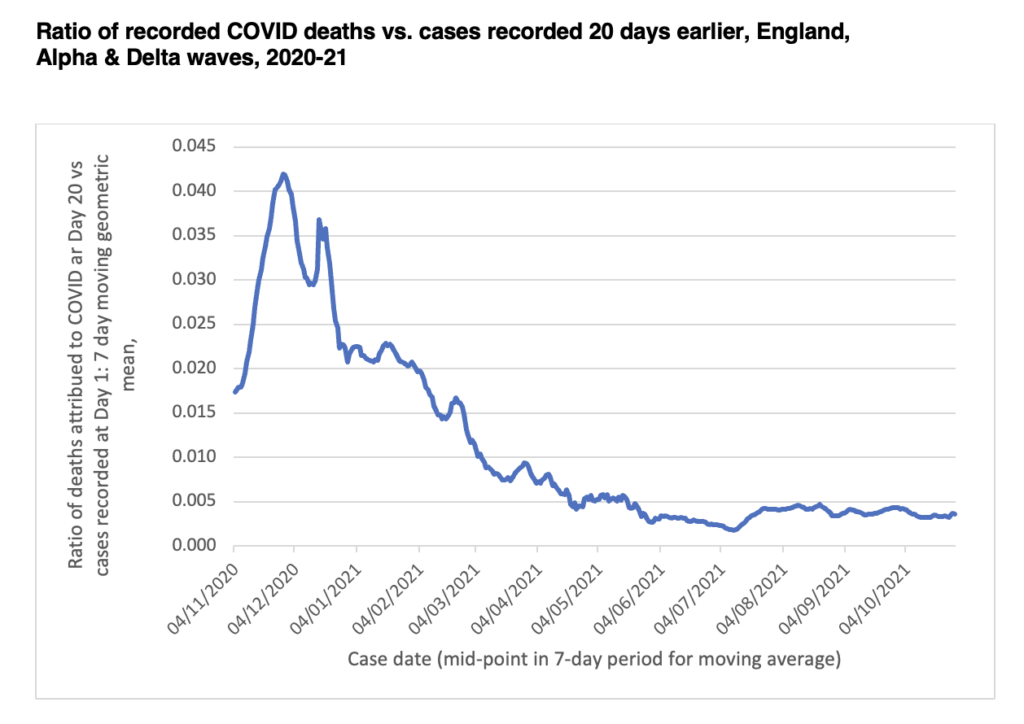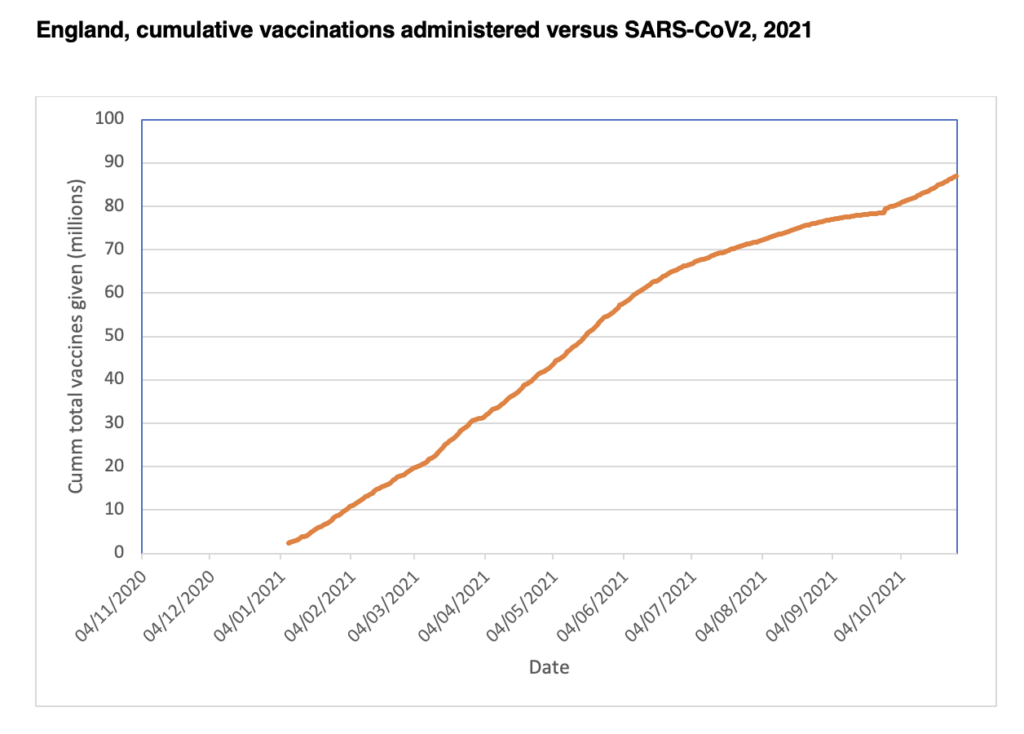I’m grateful to Will Jones and the Daily Sceptic for highlighting my article in Spiked on Dr. Ashley Croft’s report for the Scottish Covid Inquiry. You do, though, criticise me for saying that the vaccines had some benefit in 2021, suggesting that I’m being misled by a ‘Healthy Vaccinee Effect (i.e., that folk already near death are unlikely to be given a vaccine, creating the illusion that the vaccine has a survival benefit for those who did receive it).
I completely accept that a Healthy Vaccine Effect is a likely confounder of non-randomised vaccine cohort studies, particularly if the very elderly are included. I agree also with Prof Norman Fenton’s oft-made criticisms that cohort studies are distorted by counting the newly vaccinated and partially vaccinated among the unvaccinated and by the fact that the size of the UK’s unvaccinated population is grossly underestimated by the ONS. All these distortion lead to an over-estimation of vaccine efficacy.
However, my view of the vaccines’ benefit in 2021 is not based upon cohort studies. Rather, it is based on the changing death:case ratio, as illustrated below.

What I’ve done here is to take data for England and calculate a daily ratio of Deaths attributed at Day 20:Cases recorded on Day 1. Twenty days is a typical period from infection to death in a case that goes bad, and death peaks lag case peaks by around 20 days in epidemiological series. I have then smoothed the line by converting it to a 7-day moving average and, since I’m averaging ratios, I’ve preferred a geometric mean, not an arithmetic one. The dates on the X axis are the mid-point in each 7-day series: so ‘4/11/20’ is for Cases in the period 1-7/11/20 inclusive related to Deaths in the period 21-28/11/20 inclusive. I’ve kept case date rather than death date on the X axis because, obviously, cases drive deaths, not vice versa.
The graph shows a falling trend for the ratio from December 2020 to April 2021, indicating that – so long as case ascertainment and the attribution of death to Covid remained essentially unchanged – Covid became considerably less lethal through the tail of the Alpha wave, encompassing the period to April 2021.
This was precisely the period of major vaccine deployment; 2.3m doses had already been given by the data start date of Jan 10th 2021 and, by April, the vast majority of older citizens had been vaccinated (figure 2)
Notably, the Death:Case ratio remained low throughout the Delta wave of summer/early autumn 2021.

It is hard to think of a factor, other than vaccine deployment, that could cause the lowering of this ratio. There was no dramatic improvement in the care of severe cases that would have reduced the death rate; such changes, notably steroid use and avoiding ventilators where possible, came earlier. Delta, unlike later variants, was associated with substantial mortality so one can’t say that the ratio remained low because it was a mild strain.
Under-recording of cases would raise my ratio and may be a factor right at the start of the graph, so I’m not convinced that the drop is as large as 10-fold, but it is substantial. Moreover, the insanity that was mass testing was well underway by Jan/Feb 2021. I walked the two paths around London – the Capital Ring and London Loop – during that winter’s dismal third lockdown and vividly recall testing centres with snaking queues of people who looked perfectly well but had chosen to stand among the potentially infected. This testing madness really didn’t end until the omicron wave, which came after the period I’ve reviewed.
I suppose you might argue that all the most vulnerable had already succumbed by the late winter of 2020/21, so the ratio inevitably fell. This may be true to a degree; however, the majority of the population remained infection-naive until the later omicron waves, so I don’t think it can provide a substantial explanation.
So, I stand by my comments in Spiked on the vaccines’ achievements in 2021. But would add six further points, all underscoring vaccine limitations.
First, these are novel types of medicine, hurriedly developed. It was reckless to give them to groups, particularly healthy children, at zero risk of severe Covid. I consistently argued this case.
Secondly, the vaccines failed to stop infection and transmission. This weakness was apparent as early as the summer of 2021. That autumn’s coercion to be vaccinated ’to protect others’ was medically as well as morally unsound. This should have demolished the argument for vaccine passports, as I said in the Spiked article and many times previously. Yet vaccine passports were most extensively and severely imposed in that very autumn, both in Scotland and across much of the EU, where President Macron notably promised to “piss off the unvaccinated”.
Thirdly, by summer 2021 it also was clear that natural immunity confers more durable protection than vaccination. This further negated the case for vaccinating low-risk groups. It is particularly pertinent to healthcare workers. They’d better protect their patients by being infected and recovering rather than by being vaccinated. Yet care home workers in England were sacked for refusing vaccination and the same threat was held over NHS staff.
Fourth, the multi-dose boosters regimens deployed from autumn 2021 were never trialled, and ‘variant-updated’ vaccines have only been subjected to the most cursory human trials. The Cleveland Clinic’s study of its own staff suggests that repeated vaccination is associated with increased vulnerability to infection, and original antigenic sin makes it doubtful whether SARS-CoV2 vaccines can be repeatedly adapted to each emerging variant. In autumn 2021 the vaccine strategy’ departed from the last threads of evidence-based medicine.
Fifthly, there was and is a real and justifiable concern that use of vaccines targeting one highly variable part of SARS-CoV2 – its Spike protein – might become a major driver of variant evolution favouring ever-more-vaccine-evasive mutants. Natural immunity, involving a response to multiple virus proteins, should be harder to evade.
Sixth, and last, there is no justification for continuing extensive vaccination, given that circulating strains are associated with mild disease and that the great majority of us are now survivors of Covid infection, unlikely to succumb to a second attack. The JCVI seems to comprehend this, and is steadily rowing back on who should be boosted – now just the over-65s. This is in contrast to the U.S., which still advocates vaccination for anyone aged over six months.
The tragedy is that, had these vaccines been used narrowly and briefly in high-risk groups – as Kate Bingham argued – they’d be remembered well, for the achievement in 2021 that I’ve illustrated here.
Instead, for reasons that no one will yet admit the vaccination programme morphed into something very different. My expectation is it will come to be remembered badly, as the vaccine-harmed pile up for no discernible further benefit.
And my fear is that this will have a knock-on effect, leading people to eschew other and far better vaccines against more dangerous diseases.
Dr. David Livermore is a retired Professor of Medical Microbiology at the University of East Anglia.











To join in with the discussion please make a donation to The Daily Sceptic.
Profanity and abuse will be removed and may lead to a permanent ban.
Good article. ‘Hide the expansion’. ‘Hide the Arctic is not doing much of anything when compared to historical data’.
So the recent cold spell is due to the melting Arctic which blah blah causes the changey thingy blah blah and makes it colder (please send money for further ‘research’).
Except the 1% global ice volume Arctic and Greenland Ice sheets (15%) are expanding or doing not much of anything if viewed historically. So how can a stable Arctic which is not melting cause cold snaps due to plant food as stated by the climate religion? And if the winter was mild like 2 winters ago then what is the answer?
The idiocy of the Klimat-tard cult boggles, along with their fascistic pursuit of money and power. No morality in the Gaia cults. $cience. Follow the Trillion$.
These tired old bones prefer warmth to cold. I do not consider it an improvement if the Arctic is getting colder. OK, sea level is still rising gently. If anyone complains that the sea will flood homes in 100 years, ask them how old their present dwelling is – invariably much less than that.
That’s also just nonsense. Large parts of the Netherlands and Belgium have been below sea-level ever since they came to be dry land at all due to human work (and pre-industrial technology) being put into making that happen. Where sea-levels are a problem, people build dikes. They’re common throughout all of the continental shore of the North Sea.
And yet………
Melting ice caps will enable China’s military forces to “reach into the Atlantic”, the Chief of the Defence Staff has warned.
https://www.telegraph.co.uk/news/2022/12/14/chinas-military-could-reach-atlantic-ice-caps-melt-warns-armed/
That’s good to know 🙂 . If we have time to worry about the Chinese navy once the polar ice caps have melted because of climate change, climate change in itself must be harmless.
Perhaps someone will tell some bloke called Radakin, chief of defence or the suchlike, with his alarmist statement the Chinese will be able to sail round the melting poles into the Atlantic. But then again just a bid for more defence spending to be blown on civil servants and undelivered projects
Probable a stupid question, but don’t the Chinese have nuclear powered submarines that can go under the ice?
Extrapolating 30 or 40 years of Arctic sea ice to try and explain 4 billion years of climate change on our planet is like looking at a bare patch of 1 square cm of my 5 acre farm, and calling it a desert, when it is actually an abundance of green.
The pushers of the climate con do not understand context, or else are truly corrupted by a financial motive (Al Gore et al).
Definitely the latter.
Motive is more about power and control, the financial element of course comes trotting after.
Another good trick is to adjust old temps down and new temps up, creating a scary slope. Then project to the moon.
https://realclimatescience.com/rewriting-the-climate-at-nasa/
I’m fairly certain this documentary from 2007 is the one I saw on channel 4 ( obv not BBC material! ) back in the day, and ever since then I’ve known that man-made global warming to be complete hogwash;
https://www.youtube.com/watch?v=nTq8-hnDeyk&ab_channel=ClaudeStrobbe
It wasn’t that long ago The Coming Ice Age: With Leonard Nimoy was worrying over an imminent ice age and how we could potentially halt it with black soot on the ice sheets, and whatever their data back then concluded that ice age was still possible after the industrial revolution was well established (and that thing that causes all the [supposed] warming) so they know there are many [other] factors at play.
Now they’re warning of the complete opposite whilst ignoring all these other factors? Just goes to show the data can be presented to fit any hypothesis, from one extreme to another. Granted they were wrong back then, but that doesn’t mean the opposite is true now (unless of course an ice age is still on the cards). Their fraudulent data might support a warming planet, given that mini-mini ice age was used as a convenient baseline but that doesn’t make the warming (even if there genuinely was any) man made or anything outside the norms either. Why is that period considered normal and today’s not normal?
Thank god they didn’t cover the ice with black soot! Imagine the total catastrophe that would have been. Honestly, when are these people going to understand that we live on something infinitely more complex, interrelated, and balanced than we could ever imagine and that tinkering with its mechanisms is the one thing that will cause the problems we are trying to avert! Better by by far to live in this magnificent place, be a part of it as we already are, and learn to dance with its changes and adapt in a creative, harmonious way than trying to play god at every shadow that looms.
Thanks for all the data and reporting. We Greenland polar bears are especially thankful that the truth about the ice pack and the melting — hah! — of our glaciers is being told by someone in the media who is not engaged in climate propaganda. — Grandpa Polar Bear https://www.amazon.co.uk/dp/B0BQ2B29GP
Spot on article. The fact that they hide the data is 100% correct and very sad. This website below used to be fantastic and had masses of historical surface area data about ice extent in both the Arctic and Antarctic, but now it only shows the daily satellite pictures (these seem to have stopped in Sept 2022) with no surface area data.
https://cryosphere.today
I know because I used to regularly monitor the site 20 years ago.
Confessions of a Computer Modeler
“Any model, including those predicting climate doom, can be tweaked to yield a desired result. I should know.”
After three iterations [of remodeling] I finally blurted out, “What number are you looking for?” He didn’t miss a beat: He told me that he needed to show $2 billion of benefits to get the program renewed.
I finally turned enough knobs to get the answer he wanted, and everyone was happy.
Was the EPA [Environmental Protection Agency] official asking me to lie?
I have to give him the benefit of the doubt and assume he believed in the value of continuing the program. (Congress ended the grants in 1990.)
Robert J. Caprara, “Confessions of a Computer Modeler,”
The Wall Street Journal, 9 July 2014
https://www.wsj.com/articles/confessions-of-a-computer-modeler-1404861351
.
“There is something fascinating about science. On gets such wholesale returns of conjecture out of such a trifling investment of fact”——Mark Twain. ——-But in those days scientists were actually indulging in a genuine search for truth. It would be interesting to see a quote from Mr.Twain about today’s Government funded data adjusters and their genuine search for anything that seems to support public policy and ignores everything that doesn’t
Chris I think your headline is a bit unfair. If scientists were hiding the data we wouldn’t have it available to us. Its mainstream media where most of the problem lies because they refuse to accurately report on what is actually happening if it doesn’t support the crazy net zero agenda. There must be scientists who see what is really happening and who would love to report it on TV but are never given the opportunity. People like Attenborough have lost any credibility they had with anybody who does any research on climate and he has become no more than a purveyor of a lying pile of political propaganda. He is either too old or too stupid or working to a political agenda to report things accurately and he has unlimited use of our TV licence fees to do it on the BBC. While this is the case many people watch his extortionately funded programs full of inaccurate or distorted data and believe the rubbish he spouts. Surely there must be somewhere, a UK TV station to take this crap on and set the record straight.